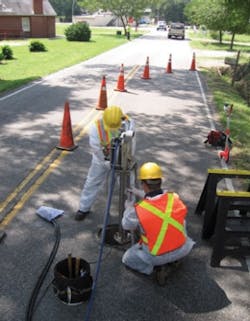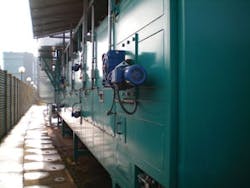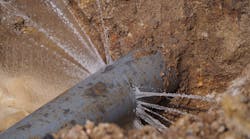A pipeline inspection system originally developed for detecting leaks in large diameter pressurized water mains is now being increasingly used for sewer force main inspections.
The Sahara® inspection system, offered by the Pressure Pipe Inspection Company, allows the line to remain in service and can detect leaks as small as 0.25 gallons per hour – in any pipe material. The system can also locate pockets of trapped gas that can cause corrosion. Tests are currently underway to evaluate if the technology can be combined with additional sensors to measure the average remaining wall thickness of pipelines.
The inspection system, which is pulled through the force main by the flow of wastewater, uses an acoustic sensor that is tethered to a cable. The cable/sensor can be stopped during the inspection and pulled back and forth to reinspect a section of pipe or confirm a reading. This provides utilities with a real-time verification of potential problems.
Recently, the Sahara system was used to inspect wastewater force mains in the Hampton Roads Sanitation District (HRSD), Virginia Beach, VA. The district's underground wastewater infrastructure consists of more than 430 miles of pressure sewer mains, 50 miles of gravity sewer mains, 61 pumping stations, and 16 pressure-reducing stations. The age of its pipe ranges from new to 85 years.
While the HRSD already has an established program for inspection and assessment of its system assets, like most water and wastewater utilities, it was not able to routinely inspect its pressure mains due to the common factors of lack of access and the need to remain in service.
After a review of the available technologies for inspection, HRSD decided to pilot test the Sahara system on a portion of its underground assets.
"The HRSD chose Sahara because its system had many lines that had two-inch diameter air release valves," said Kelly Derr, P.E., and technical consultant with Brown and Caldwell. "They determined that this was a very cost-effective tool when used as a first-step analysis, because it allowed an inspection to be performed while the pipe was still in service."
A pilot project of pipe of varying materials and diameters was created to evaluate the inspection technology. Following the pilot run, the HRSD concluded that the acoustic system provides useful information on active leaks and on gas pockets in the system. With the effectiveness of the technology proven, the extension of this project is on track.
Conclusion
Inspection devices such as inline acoustic tools are increasingly being used by utilities to better manage force main assets.
Understanding the true condition of mains through routine inspection helps to ensure environmental compliance, extend the life of assets, and reduce capital and operating costs by finding potential issues before they escalate into major problems.
The acoustic sensor is drawn through the sewer force main using a parachute device.
"Utilities are beginning to understand that they have assets in the ground that they don't know anything about," Derr said. "However, due to pressure from regulatory and governmental bodies, detailed inspection of these assets is now necessary."
"Acoustic systems like the Sahara system are a great tool because you can get them into a force main fairly easily, they can be inserted while the force main is still live, and they give you an initial screening pass of where there might be a problem," he said. WW
More WaterWorld Current Issue Articles
More WaterWorld Archives Issue Articles





